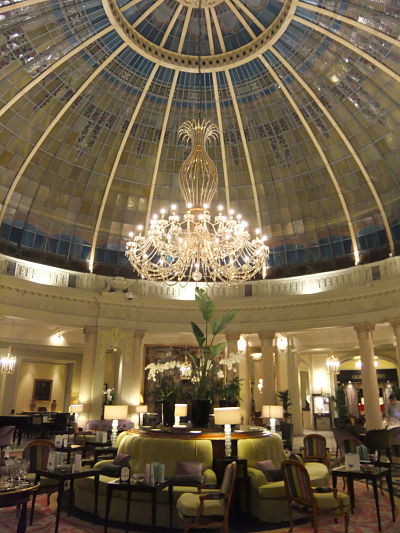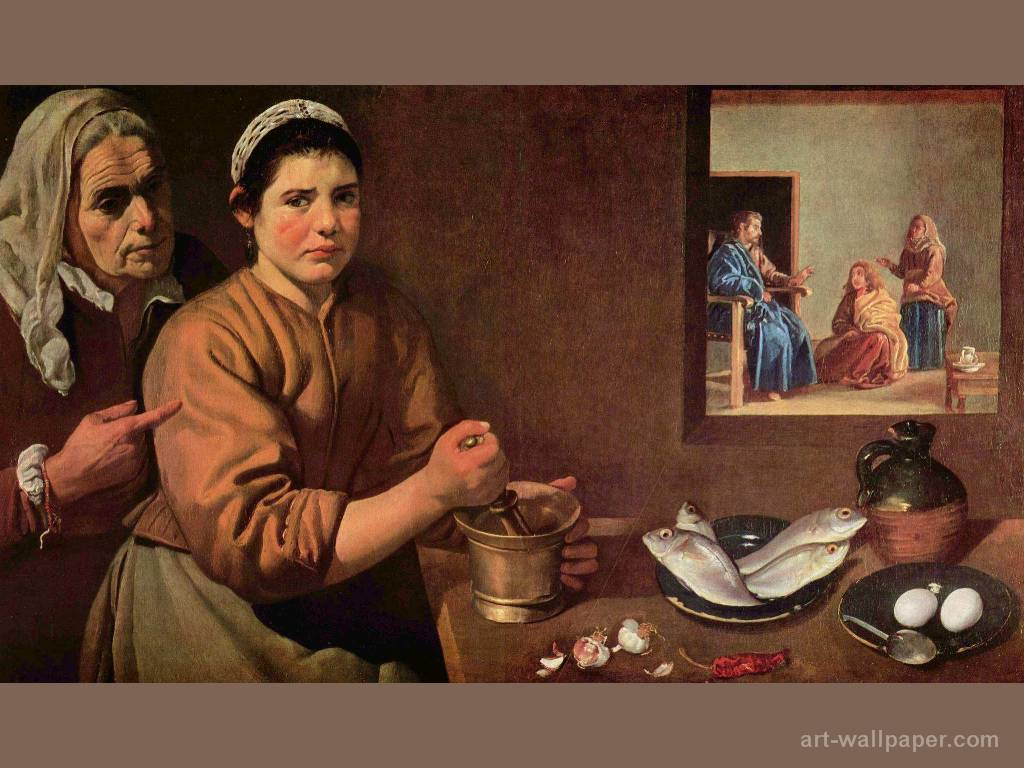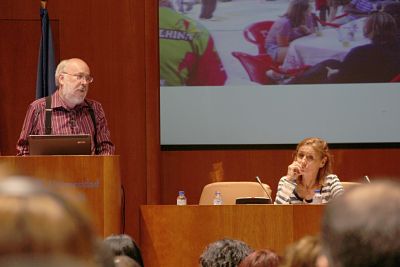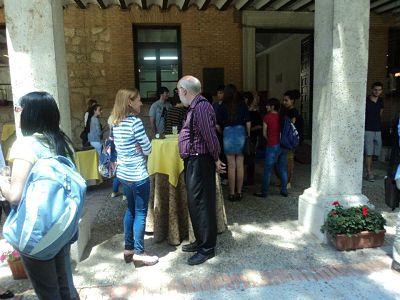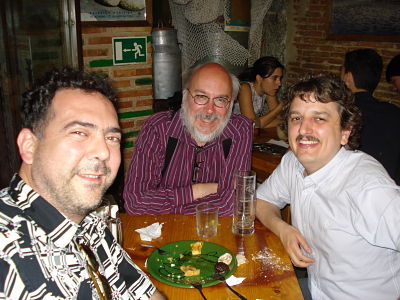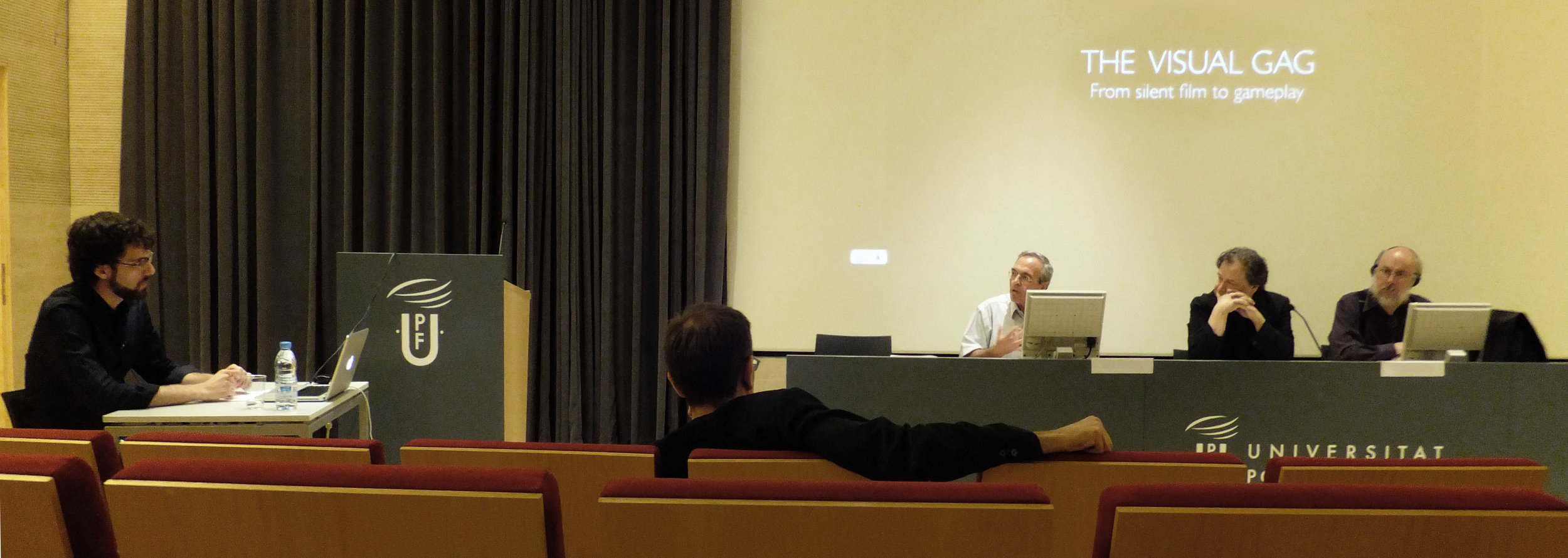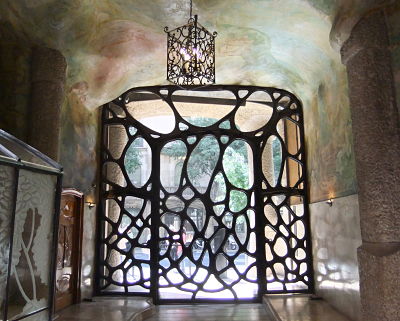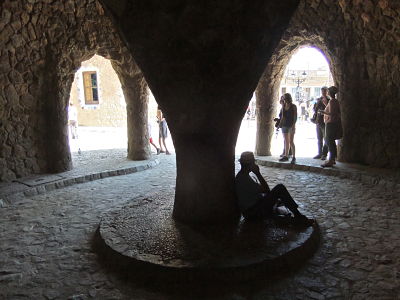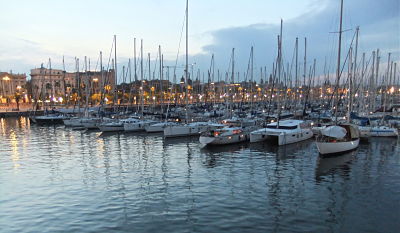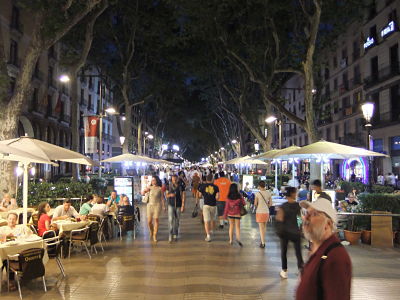How I Spent My Summer Vacation: Spain
/Madrid, Spain My time in Madrid was one of the most intense legs of the trip: I delivered five talks in three days and most of the time in between was spent doing interviews with the local media. As a consequence, I had very limited time to see this great city and my exposure to its culture mostly consisted of quick meals in between talks.
While in Madrid, we stayed in a really luxurious grand hotel, the aptly named Westin Palace, just a few blocks away from the Prado Art Museum, thanks to the generosity of Telefonica, which was sponsoring my big public talk here.
After checking in, we wandered over to the Prado to soak up a little culture. Personally, what drew me here was the chance to see Hieroymous Bosch's Garden of Earthly Delights, a work which has fascinated me since I first wrote a paper about it in high school: I still can't figure out how to place Bosch in the context of his times. Where did this guy come from? Almost as astonishing to us were some of the religious paintings -- such as one where milk shoots out of the breast of the Virgin Mary and across the room into the mouth of a praying saint. (We found that there was a consistent fascination with this particular bodily fluid in religious art across Europe.)
Not surprisingly, Spanish artists, such as El Greco, Goya, and Velazquez, were especially well represented in the collection, and it was breathtaking to experience the size and intense colors of some of these works. Perhaps my favorite discovery on this visit was Velazquez's Christ in the House of Mary and Martha.
First, I was intrigued by the way the picture manages to combine three genres -- the still life, the domestic portrait, and the religious painting -- within a single image. Second, I was fascinated by the ways that the picture juxtaposes and contrasts two very different spaces of action -- the foreground in the kitchen, the background in the dining room -- and links them thematically to the core Biblical story of the two sisters, Martha busily preparing the meal, while her sister, Mary, sat at Jesus's feet and listened to his word. I have been spending lots of time thinking, especially about still life paintings, but also other works which include a strong attention to material culture, in relation to my new Comics and Stuff project. I ended up grabbing a picture off the internet and incorporating this work intoa talk I gave in Madrid about this project.
The following morning, Pilar Lacasa picked me up at the hotel and drove me out to the University of Alcala to present "The Samba School Revisited: Play, Performance, and Participation in Education. Lacasa has been a frequent visitor to the Comparative Media Studies program through the years, where she sat in on classes, participated in conferences, and contributed to our research. I've featured her own work on games-based learning and new media literacies through the blog before. It was meaningful for me to finally get a chance to visit her at her host institution and interact with her students. The talk was adapted from this blog post, which I wrote about the ways my own thinking about participatory culture was influenced by Seymour Papert's classic essay about the Samba School as a site of informal learning. The talk started with my own observations about how one of Rio's Samba Schools encouraged multiple forms of participation in the creative process.
Here, you see Pilar sitting next to me on the podium during the talk:
and me interacting with some of her students in the coutryard afterwords.
That evening, I paid my respects to another friend, Nacho Gallego Perez, who asked me to present my Future of Content talk at the Campus of Leganes, organized by Research Group about Television, Cinema, and Culture at Universidad Carlos III. Perez, who does work on grassroots use of digital radio and podcasting in Spain, had given a guest lecture in my New Media and Culture class at USC and participated in a workshop my Civic Paths group organized for MacArthur's Digital Media and Culture conference. Nacho and Luis Albornoz took me out afterwards to enjoy Tapas.
After a morning of interviews organized by Telefonica, I went out to give a talk about "Comics..and Stuff" at Universidad Rey Juan Carlos, hosted by Jose M. Alvarez-Monzoncillo, who is a leading thinker about the cultural industries. I featured Alvarez-Monzoncillo's book, Watching The Internet: The Future of TV? on my blog shortly before I left for the trip. You can see me here trying to reach up high enough to point out some details on a Richard Outcault comic page.
No sooner did I arrive back at my hotel, then another host, the international media literacy advocate Roberto Aparici, arrived to pick me up. I met Roberto years ago at MIT, when Textual Poachers was first coming out and he was in residence working on an early interactive media project. Roberto and I sat down in a studio at a local educational television station to record a most enjoyable conversation which explored our shared interests in new media literacies and participatory politics.
And then, I talked about Play and Pedagogy as the final speaker at the Seminario internacional Redes sociales, educacion mediatica y apprendizaje digital, an event which brought together practicing teachers and educational researchers.
My talk was preceded by a presentation on the affordances of social media by Gunther Kress (University of London). Kress's work on "Multimodal Literacy" offers some valuable conceptual tools for thinking about transmedia learning, and so I was honored to have a chance to chat with him, however briefly. Here's a video interview with Kress I found on YouTube.
http://www.youtube.com/watch?v=nt5wPIhhDDU
And, then, after a full day of talks, I arrived back at the Telefonica Foundation's headquarters in time to join a group tour of the old sector of Madrid and a wonderful dinner with my fellow speakers.
 Telefonica's Transmedia Living Lab had pulled together some of the top thinkers about transmedia in Europe for a three day event, which tackled its implications for storytelling, learning, and social change. My other commitments kept me from attending most of the events, but I very much enjoyed getting to chat with my fellow speakers over dinner.
Telefonica's Transmedia Living Lab had pulled together some of the top thinkers about transmedia in Europe for a three day event, which tackled its implications for storytelling, learning, and social change. My other commitments kept me from attending most of the events, but I very much enjoyed getting to chat with my fellow speakers over dinner.
I was especially taken with Lina Strivastava, a transmedia consultant who has been developing a tool kit for transmedia activism, inspired by her experiences developing a campaign around the Born in Brothals documentary, and Bill Boyd, a educational consultant and teacher working in Scotland, who has been doing some serious thinking and writing about new media literacies through his blog. Boyd has shared some interesting thoughts about the Madrid conference. You can find video and slides from the conference here.
My talk, "'Occupying' the Transmedia Landscape: Spreadable Media, Fan Activism, and Participatory Learning” used the Occupy Wall Street movement as a point of entry into thinking about how activists are embracing grassroots practices which combine remix, transmedia, and spreadability, to get their messages out to the widest possible audience. The talk was partially inspired by this blog post on the discursive and visual tactics of Occupy.
Barcelona
My main professional reason for coming to Barcelona was to participate in a dissertation defense for Manuel Garin, a gifted PhD student in Humanities and Audiovisual Communication at Universitat Pompeu Fabra, Barcelona. I first became aware of Garin's work on The Visual Gag, when he shared with me this remarkable video that juxtaposes a sequence from Buster Keaton's silent film, Seven Chances, and footage from the Super Mario Brothers games, to help construct an argument about the ways that classic stunts and gag structures have traveled across time and across media.
http://www.youtube.com/watch?v=bEyfaM9pQBE
Garin presented some of his preliminary ideas about games and silent cinema through this blog post and he had spent some time in California doing research through the USC Cinema School for his project. Garin has an encyclopedic knowledge of the history and aesthetics of gags, not the mention to read across a range of European languages, and thus, to make connections between different theoretical traditions which have sought to understand the place of the gag in media history. Across the dissertation, he explores thousands of gags from films, television, comic strips, games,and popular theater, moving fluidly across national traditions and criss-crossing divides between popular culture and avant grade practice.
The process of the dissertation defense was very different from my experiences in American universities. For one thing, the defense is public -- in this case, very public, since it was attended not only by Garin's family and friends, but also by the attendees of a conference his university was hosting that day on the cinematic gesture, and thus, we conducted everything in front of a packed auditorium. For another thing, it is a highly performative. The candidate gives extensive remarks presenting the core ideas from his project -- in this case, complete with power point and video clips. Then, each committee member speaks about the project for 10-15 minutes and finally the candidate gets to offer a formal rebuttal/response to what has been said. There is no chance for back and forth exchange between the parties involved, as I might have expected back in the States. In this case, each person who presented spoke a different language -- Spanish, Catalan, Italian, and English. I was told in advance that there would be no translation, since it was less important that the committee members understand each other than that what they had to say was understood by the candidate, but we were able to take advantage of the translation services organized by the conference.
Afterwards, I was approached by Robert Figueras and Gemma Dunjo, who are responsible for Panzer Chocolate, which is being billed as the first major transmedia project in Spain. I had been told about it multiple times by this point in the trip. This horror story is told across a feature film, a video game, a motion comic, an alternate reality game, mobile interactivity and "an Internet surprise.' Here is a trailer they have produced which gives some sense of their approach.
http://www.youtube.com/watch?v=31Ed4pz8sXc
My other formal business in Barcelona involved a meeting with Felipe G. Gil, a digital artist, theorist, and activist, based in Seville, who has been promoting the concept of "CopyLove." Inspired by feminist theory and modeled on the idealized concept of maternal love, this approach seeks to imagine what copyright regimes would look like if they were shaped by ideas of reciprocity, caring, nurturing, and sharing, rather than property, mastery, control, and profit. I had shared on my blog some of Gil's reflections on transmedia and digital literacy, which drew on the remix practices of his young cousin, a few years ago. Here's a Ted video where Gil explains some of his concepts in Spanish.
http://www.youtube.com/watch?v=K8msyNpPQRM
Afterwards, we were free to explore the city. Perhaps it was simply that my schedule had been so intense for the past week, perhaps it had to do with the considerable charms of Barcelona, but I felt giddy and liberated, and fell pretty madly in love with this city. I suspect I am far from unique in saying that my fascination with Barcelona is to a large degree shaped by my engagement with Antoni Gaudi's amazing buildings. Gaudi is perhaps the best known exemplar of what has become known as Catalan Modernism, creating a series of remarkable residences, apartment buildings, churches, and public parks, especially in Barcelona, in the first part of the 20th century. Gaudi took certain tendencies in the Art Nouveau movement and pushed them in other worldly directions. The sensuousness of his structures have to be seen and experienced to be fully understood, but they are such a wonderful play with shape, color, light, and texture, that I found utterly seductive. Here, Cynthia's photographs only give you a taste.
At the same time, there is a strong geometric pull in Gaudi's work, which elaborated on gothic traditions of architecture in order to explore arches in ways that open up radically different kinds of spaces within his buildings.
Every room in a Gaudi building is a surprise -- most of them, breathtaking. Here, you get a sense of how consciously he plays with light, exploring the relationship between interior and exterior spaces, to create a series of thresholds which we pass through as we move from room to room. Here, also, one gets a sense of the subtle and expressive use of color throughout his designs.
We spent more time with Gaudi's residences -- Casa Batllo and La Pedrera -- rather than his public buildings. But here, you see Sagrada Familia, his massive cathedral, which has been under construction for the better part of the past century. Given the centrality of the Cathedral to any visit to Europe, it was fascinating to see how Gaudi brought his idiosyncratic touches to this genre.
We also made our way out to Park Guell, a public space and gardens, which is enriched by Gaudi's sculptural and architectural elements. This park is a very active element in the public and everyday life of Barcelona, so while the residences now have the feel of museums, and are cut off from their original use, here, you can see contemporary Catalans interact in casual and everyday ways with his designed environments.
OK, by now, I have demonstrated why I chose to enter media studies and not architecture. My relationship to this work is largely emotional and intuitive, rather than intellectual, and I lack the basic vocabulary to describe what I saw when I visited these buildings. I should note that from time to time in these photographs, you will see me wearing a white baseball cap. I actually purchased it at one of the Gaudi gift shops. I was looking for something to protect my bald head from the sun and couldn't decide on what to advertise on my pate. The hat features simply the letter, J, as rendered in a font which Gaudi designed.
We were consistently amused by the vividness with which European street signs conveyed the many risks that surround us in the modern world. Sign after sign depicted what could happen to us if we make a single misstep in navigating a world of danger. I came to see them as a kind of conceptual humor, or perhaps the pictorial equivalent of slapstick comedy. I am going to share some in future posts. This sign, spotted in Barcelona, might be suggesting "slippery when wet," or more imaginatively, "please do not jump rope on these stairs," or perhaps, "beware of snakes." In any case, you should try to avoid this poor sucker's fate.
We spent the better part of two days playing tourists in Barcelona, taking advantage of the red hop-on, hop-off buses to sample many different sectors in the city. And as the day started to turn into night, we visited the Aquarium and then walked along the water front.
And, as the night continued, we took a lively midnight walk up La Rambla, where we stopped to watch street gambling, a range of live performances, and simply the back and forth bartering between visitors and merchants. As someone who is a bit of a night owl by temperament, it was exciting to be some place where there is so much public life still being conducted in the wee hours of the morning. We were exhausted from an intense day of sight-seeing and pretty much limping back to our hotel, but you had a sense that many of these people were just getting started.
NEXT UP: ITALY AND SWITZERLAND


